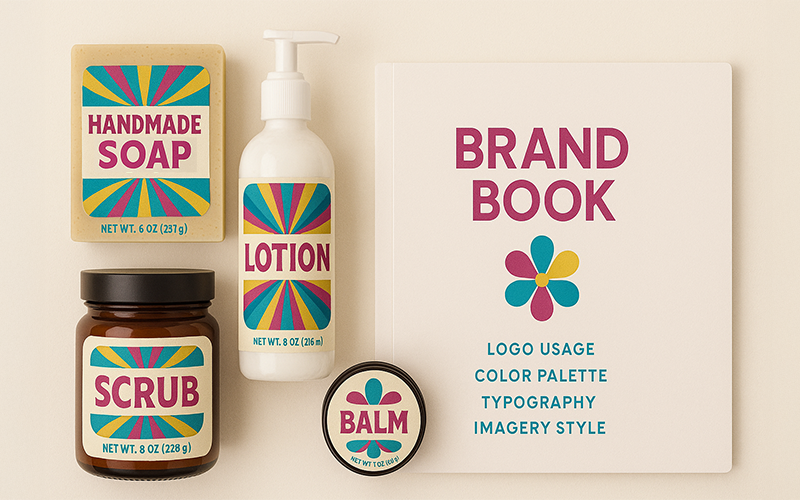When most people hear “brand book,” they think of large corporations with thick binders full of rules about logos and fonts. But a brand book can be just as valuable for small soap and cosmetic businesses. Whether you’re selling at farmers’ markets, in local shops, or online, a brand book keeps your business image consistent, professional, and recognizable.
And—unlike the standard corporate version—your brand book should also cover how your branding applies specifically to your product labels, since those labels are where your brand meets both customers and regulations.
Let’s take a closer look at what a brand book is, what goes in it, and why it’s worth creating one for your business.
Why Consistency in Branding Matters
Branding isn’t just about having a nice logo. It’s about creating a cohesive whole—a set of colors, fonts, images, and tone that all “speak the same language.”
When your brand feels unified, then your customers:
- Recognize your products instantly, no matter where they see them.
- Build trust, because a consistent look signals professionalism and reliability.
- Remember your products more easily, making repeat sales more likely.
The Risk of Mismatched Branding
Imagine this: you want your line to feel elegant and luxurious, so your lotion labels use black and gold with sleek modern fonts. But then you print soap labels with country-chic gingham patterns and rustic farmhouse fonts.
What message does that send? To customers, it looks like two different businesses—or worse, like one business that doesn’t know who it is. That kind of confusion makes it harder for people to trust you, and harder for them to remember (and repurchase) your products.
Consistency doesn’t mean every label looks identical—but everything should feel like it belongs to the same family.
What Is a Brand Book?
A brand book (sometimes called brand guidelines or a style guide) is a reference document that explains how your brand should look, feel, and sound wherever it appears. It’s like a uniform for your company.
Think of it as your business’s “user manual” for branding. It ensures that whether you’re designing a lotion label, posting on social media, or creating signage for a booth, everything works together to present one consistent image. It gives you a standard to refer to any time you are creating something new or grooving in a new graphic designer or employee.
For a soap or cosmetic maker, that’s especially important because your labels are tightly regulated. A brand book helps you balance compliance with creativity—so your labels are both legally correct and visually consistent with your overall brand.
What Goes in a Brand Book?
Most corporate brand books contain a standard set of sections. For small soap and cosmetic businesses, ideally you’d want to include all of those plus a section specific to product labels.
Brand Basics
- Mission and values – Why you do what you do and what matters most in your business.
- Target customer – A description of your ideal customer (age, interests, values).
- Brand personality – The “voice” of your business: playful, elegant, natural, professional?
Visual Identity
- Logo – Approved versions, spacing, size limits, and where to use each one.
- Color palette – Your color choices, with the exact color codes (RGB, CMYK, Hex, Pantone) for consistency across print and digital.
- Typography – Selected fonts to be used for headlines, body text, and accents.
- Imagery style – Guidelines for photography or illustrations (e.g., clean white backgrounds, natural lifestyle shots, vintage line drawings).
Voice and Messaging
- Tone of voice – How your business “sounds” in writing (casual, informative, supportive).
- Tagline(s) – Any key phrases to use consistently.
- Word choices – Words or phrases that fit your brand (and those to avoid).
Examples of Brand Elements Across Styles
Here’s a quick look at how two very different brand identities might define their elements consistently.
| Element | Luxe & Elegant Brand (Spa feel) | Country Chic Brand (Farmhouse feel) |
|---|---|---|
| Logo | Simple monogram in gold foil | Hand-drawn barn or floral sketch |
| Color Palette | Black, white, metallic gold | Cream, sage green, soft barn red |
| Fonts | Thin modern sans-serif + elegant serif | Rustic script + friendly slab serif |
| Imagery | Minimalist photography, clean backgrounds | Natural light, farm settings, vintage props |
| Tone of Voice | Calm, refined, spa-like | Warm, cozy, “homemade” |
| Label Example | White background, gold foil logo, sleek text | Kraft paper look, floral border, script headline |
Both work beautifully—but if you mix and match (a gold-foil logo with a gingham label), your branding stops telling a clear story.
Application Examples
- Social media – How your brand identity shows up in posts, hashtags, and captions.
- Website – Layout and style that align with your brand.
- Marketing materials – Business cards, flyers, banners.
- Business documents – Letterhead, invoices, email.
Label-Specific Branding (the extra section you need)
This is the piece that most standard brand books don’t need—but for soap and cosmetic makers, it’s essential.
In this section, document:
- Brand placement on labels – Where the logo appears, how large it should be, and how to maintain visibility while still leaving room for required information in the required size(s).
- Color and font rules for labels – Text size, style, and color for the required elements on the label (net contents, ingredient declaration, business name and address).
- Consistency across products – How different product lines (soaps, lotions, scrubs) and product sizes (large, small) should “look related” while still being distinguishable.
- Marketing copy guidelines – Rules for claims, descriptions or product specific tag lines so they stay within cosmetic definitions (avoid drug claims, keep descriptions truthful and not misleading).
- Examples – Mockups of compliant labels with notes showing how branding and regulations work together.
Label Elements in Different Brand Styles
Following the earlier example, here’s how our two different brand identities might define their label elements consistently.
| Label Requirement | Luxe & Elegant Brand Example | Country Chic Brand Example |
|---|---|---|
| Label Stock | White glossy | Kraft Brown |
| Product Name | Elegance – Gold Embosed Script | Clean Comfort – Deep pink, large script across top |
| Identity Statement | “Hydrating Body Lotion” in sleek sans-serif font, black | “Handcrafted Oatmeal Soap” in , deep green |
| Net Contents | Small caps, sans-serif font, centered, accent color #2 | Sans-serif font in upper/lower case, right side accent color #1 |
| Ingredient Declaration | Left-aligned list in modern serif, black on white | Right-aligned list in plain san-serif, dark brown |
| Warnings/Notices | Discreet italic line at bottom, small but clear | Framed in a decorative border, slightly larger font |
This shows how the same label elements can be styled to reflect your brand’s identity without sacrificing compliance.
Final Thoughts
A brand book may feel like “extra work,” but it saves time and prevents problems down the road. It doesn’t doesn’t need to be a 200-page corporate manual—even a 10–15 page guide can give you a powerful tool to keep your soap or cosmetic business on track. With it you’ll get:
- Consistency – Customers recognize your products instantly, no matter where they see them.
- Professionalism – A consistent, polished look builds trust and makes your products stand out.
- Efficiency – If you hire a designer or printer, your brand book gives them clear instructions.
- Compliance – With labeling rules built in, you reduce the risk of mistakes that could make your labels noncompliant.
- Scalability – As your product line grows, your brand stays cohesive instead of looking piecemeal.
And by including a section on label branding—something most corporate guides don’t really need—you’ll ensure your products look beautiful and meet regulatory requirements.
For small businesses, especially those with products in multiple retail environments, this consistency is what makes the difference between a hobby-level brand and one that customers (and retailers) take seriously.
If you haven’t created one yet, start simple. Write down your logo, colors, fonts, and some label mockups. Over time, expand your brand book into a complete guide. Your future self (and your customers) will thank you.


Leave a Reply